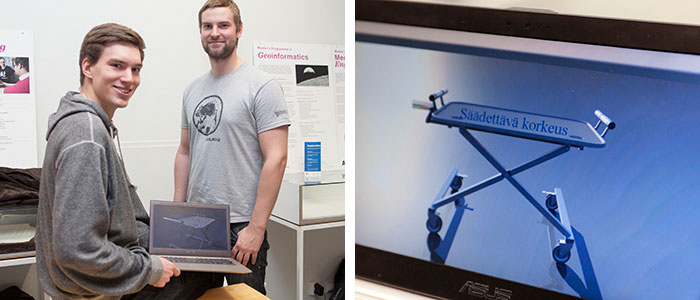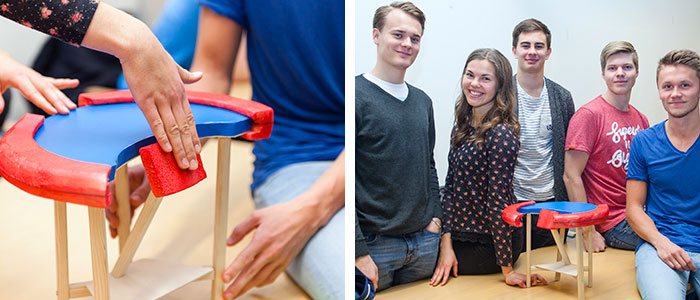Product Design Gala presented tools for hospital patients
The theme of the product development course was devices that could help hospital patients stay active without leaving their hospital beds.

The course culminated in Product Design Gala, which featured over 200 BSc students presenting their groups’ ideas aimed at helping bed patients carry out everyday tasks independently and without added health risks.
The course in product development is mandatory for all students of mechanical and structural engineering, but participants also included students from other programmes.
Adjustable hospital desk
“There were many problems to solve, so the first five of the course’s six weeks were spent on background research and narrowing our focus”, said Tuukka Tuomela.
“Our idea is an adjustable hospital desk that could solve at least a few of those problems. However, it isn’t suitable for patients in very poor condition”, he adds. “The desk helps a patient eat, as it can be adjusted to an appropriate height.”
The group found the task challenging, as none of them were familiar with the hospital environment. “The same design process can still be applied in designing other products going forward.”
The group included three students from the School of Electrical Engineering, two from the School of Chemical Technology and one School of Engineering student majoring in energy and environmental engineering.

In the photo from left: Tuuka Tuomela and Arno Alho. Other group memembers are Niko Luostrinen, Artem Lopatenko, Santeri Santikko and Mihael Merkurjev.
Work surface with integrated seat support
“Our assignment presented a host of challenges”, said Jami Kajander, who is majoring in mechanical and structural engineering. “The patient should be able to sit on the edge of their bed in a safe manner while maintaining their human dignity.”
“I think we were quite successful”, said NN. “We ended up designing a work surface with an integrated seat support that can be adjusted by the patient. The chest and foot supports are also adjustable.”
“Both of us are headed for the field of construction, so an assignment like this may be the last of its type for us, but the experience of working in a group is useful.”
Bound for mechanical engineering, NN thought the assignment was a positive experience. “The greatest element was the opportunity to combine creativity with technology and think of different solutions. The timetable was a challenge, and in the end we had very little time to complete our model.”
The six-member group included five students of mechanical and structural engineering and one student of industrial engineering.
The product design course was carried out by the Department of Mechanical Engineering at the School of Engineering.

Group members from the lefft: Rolf Kottelin, Anna Lagerström, Jami Kajander, Petter Westberg, Filemon Wolfram. In addition Casper Fagerström belongs to the group.


